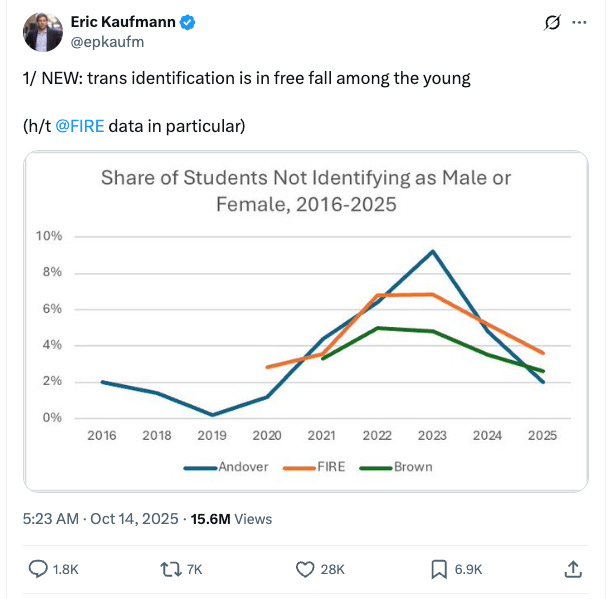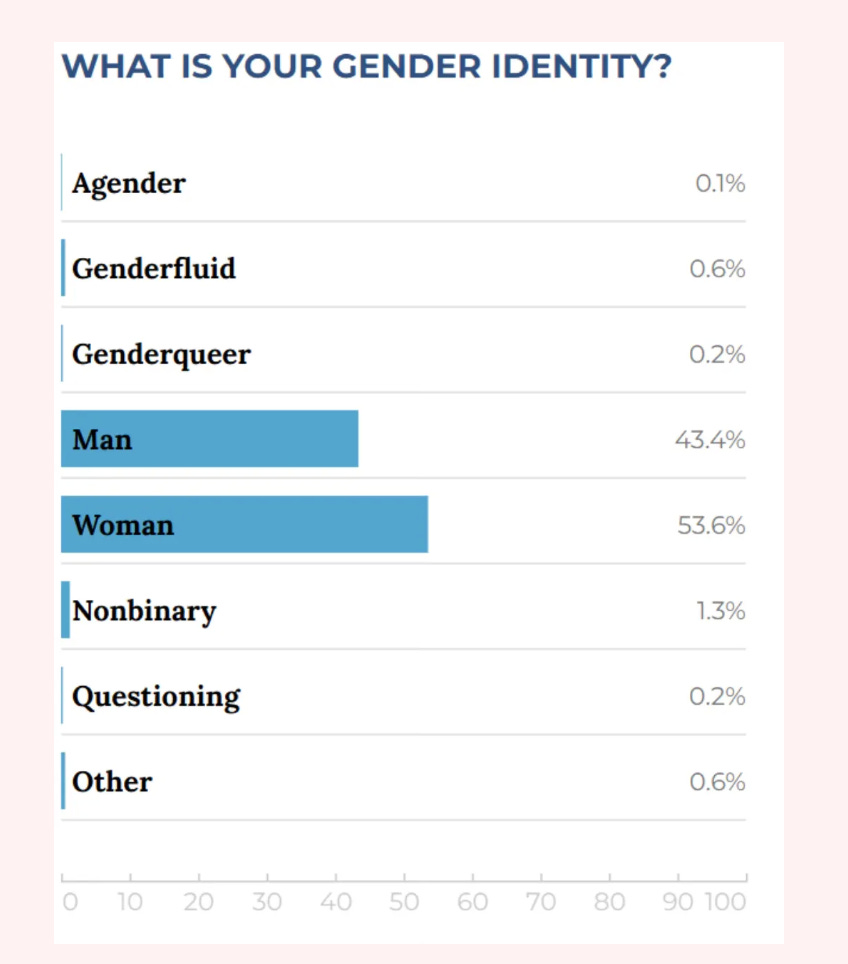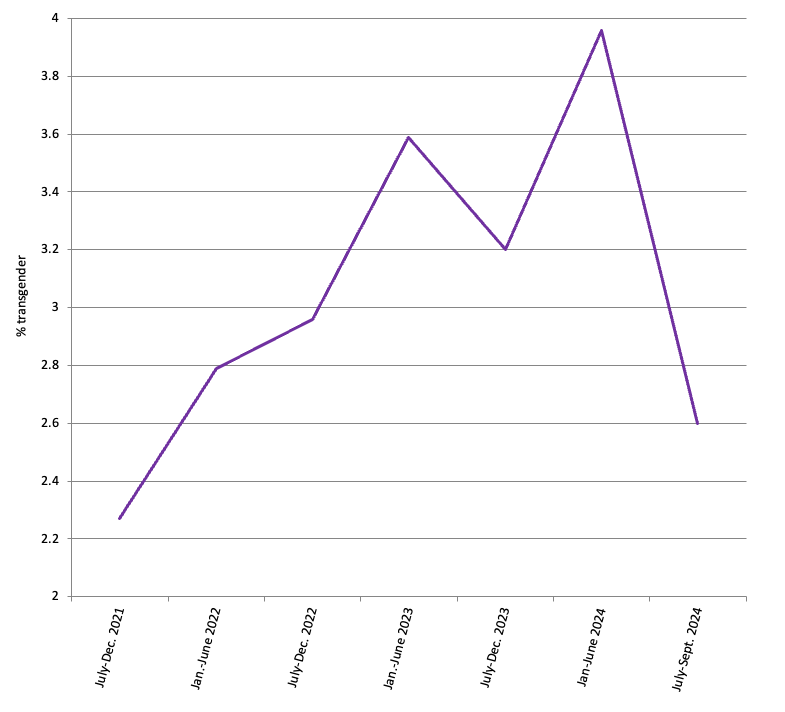Is transgender identity really declining among young adults? What the real data says
Plus: the consequences of the Trump administration's policy on sex and gender
Earlier this week, a new report found that the number of young Americans identifying as transgender or nonbinary peaked in 2023 and has plummeted since.
The report got a lot of attention (for example, over 15 million views on X and a retweet by Elon Musk), perhaps because it concluded that a shift in cultural attitudes might be responsible for both the increase 2019-2023 and the decrease 2023-2025 in young people identifying as transgender or nonbinary.
Eric Kaufmann, who wrote the report, concluded that the decline “seems most similar to the fading of a fashion or trend.” It could also be that more people were willing to identify as transgender or nonbinary when they thought this would be accepted and are less willing to do so when it would not be.
Either way, it’s an intriguing finding, showing whiplash-quick cultural change over the period of just a few years. But is there actually a population-wide decline in transgender identity?
That’s impossible to say with this data. Strikingly, as Benjamin Ryan noted, these three surveys don’t ask about “trans identification” at all, as Kaufmann’s tweet says. Instead, they ask about identifying as nonbinary, gender fluid, and so on. Here are the choices in the Andover survey, for example:
The Brown and FIRE surveys were similar, asking about nonbinary and gender queer identification. None of these three surveys used the word transgender. So there might be a decline in identifying as nonbinary, but these data tell us nothing about trends in transgender identification.
These are also not representative samples. Two of the data sources for this graph are extremely selected populations: students at Andover (the most elite boarding school in the country) and students at Brown (an Ivy League campus with a 5% acceptance rate). These samples are very unrepresentative of the population of U.S. young adults as a whole.
The third data source is a FIRE survey of U.S. undergraduates in four-year degree programs at 257 research universities. This sample is more representative than the other two but still does not reflect the majority of 18- to 22-year-olds, most of whom attend less selective four-year colleges, go to community college or trade schools, or are not in college at all.
Since I’ve written about generational trends in identifying as transgender before, including in this newsletter as well as in Generations, I immediately wondered what nationally representative data that actually asks about transgender identity would show. That would tell us if this really is a population-wide trend, versus something happening only in selected, elite groups. It would also help rule out the possibility that the trends were caused by differing admissions standards or self-selection into or out of these schools rather than a true change. And it would show us trends in identifying as trans, not trends in identifying as nonbinary or gender queer.
So has transgender identification declined among the population of young adults as a whole?
The short answer: Maybe. The Household Pulse survey, administered by the U.S. Census Bureau, included a question about identifying as transgender in its nationally representative samples between July 2021 and September 2024 (why not any later? I’ll get to that in a bit). Among 18- to 22-year-olds, identifying as transgender increased 58% between late 2021 and early 2023 – a period of 18 months. Then it bobbled a bit, going down in late 2023 and then back up into early 2024 to nearly 4%.
By late 2024, though, identifying as transgender had fallen to 2.6%, a little less than in early 2022 (see Figure 1). It appears identifying as transgender peaked in early 2024 among younger adults even at the population level.
Figure 1: Percentage of 18- to 22-year-old U.S. adults who identify as transgender. Source: Household Pulse Survey, July 2021-September 2024. Note: The question asked “Do you currently describe yourself as male, female or transgender?” Data are weighted.
As you can see in the figure, though, there are some ups and downs, so it’s hard to say if the late 2024 decline is a blip or the start of a longer trend. Another caveat: In two of the three administrations in late 2024, an additional response choice for “nonbinary/I use another term” was added to the previous choices of male, female, and transgender. If that took away from the number identifying as transgender, it could be the reason for the decline.
Thus, we’d ideally want data from 2025 to verify that the decline has continued, or at least more data from 2024. Why don’t we have it? The Household Pulse survey fielded in February 2025 no longer asked about identifying as transgender — at least, the datafile doesn’t include that item. Another nationally representative survey of U.S. adults, the Behavioral Risk Surveillance System administered by the CDC, asked about transgender identity from 2014 to 2023, but that item was absent from the recently released 2024 datafile.
I assume this occurred because of the Trump administration’s directive to federal agencies that there are only two sexes, male and female, and that gender identity is not to be measured or recognized. Although many believe there are benefits to this policy, it has another (intended or unintended) consequence: It means we no longer have a clear picture of how many Americans identify as transgender in nationally representative datasets.
Many people are interested in this data regardless of their political beliefs; if anything, those on the right seem more interested in trends in transgender identity than those on the left. But we can’t find out what the trends are with the nationally representative data if federal agencies don’t ask about transgender identity or don’t report the data when they have it. Since the BRFSS data was all collected in 2024, that data exists, but was — I am guessing — purged from the datafile.
That is deeply unfortunate, because without that data, we’re in the dark.






